
Ormonde was an undefeated English Thoroughbred racehorse who won the 1886 English Triple Crown and was labelled the 'horse of the century' at the time. He also won the St. James's Palace Stakes, Champion Stakes and the Hardwicke Stakes twice. Ormonde was trained at Kingsclere by John Porter for the 1st Duke of Westminster. His regular jockeys were Fred Archer and Tom Cannon. After retiring from racing he suffered fertility problems, but still sired Orme, who won the Eclipse Stakes twice.
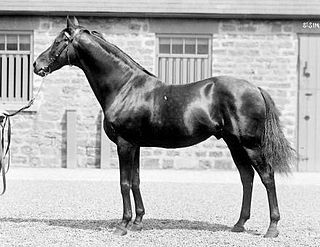
St. Simon was an undefeated British Thoroughbred racehorse and one of the most successful sires in the history of the Thoroughbred. In May 1886 The Sporting Times' carried out a poll of one hundred experts to create a ranking of the best British racehorses of the 19th century. St. Simon was ranked fourth, having been placed in the top ten by 53 of the contributors.
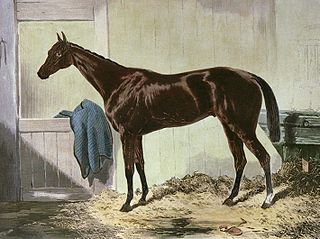
Blue Gown was a British Thoroughbred racehorse that was the winner of the 1868 Epsom Derby and Ascot Gold Cup. He was one of the best colts of his generation at two, three years and four of age, but his form declined in 1870 after an unsuccessful period in France. He was retired to stud, where he had considerable success as a sire of winners in Germany. Blue Gown died in 1880 while being shipped to the United States.

Sir Hugo (1889–1910) was a British Thoroughbred racehorse and sire. In a career that lasted from 1891 to 1894 he ran eight times and won three races. As a three-year-old in 1892 he won The Derby at odds of 40/1. He was a consistent performer in top class races, but certainly inferior to his contemporaries Orme and La Fleche.
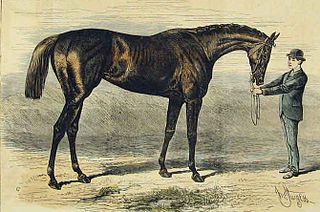
Shotover (1879–1898) was a British Thoroughbred racehorse and broodmare. In a career that lasted from 1882 to 1884, she ran 15 times and won five races. As a three-year-old, racing against colts, she became the first filly to win the first two legs of the English Triple Crown: the 2000 Guineas at Newmarket and the Derby at Epsom. She went on to win twice at Royal Ascot, but failed in her bid for the Triple Crown when she finished third in the St Leger at Doncaster. She was retired in 1884 and became a successful and influential broodmare. Shotover died in 1898.

La Fleche (1889–1916) was a British Thoroughbred racehorse and broodmare. After being sold for a world record price as a yearling in 1890, she was undefeated as a two-year-old in 1891, winning races against her own sex and defeating some of the year's leading colts. She went on to become the dominant British three-year-old of 1892, claiming the Fillies’ Triple Crown by winning the 1000 Guineas at Newmarket, the Oaks at Epsom and the St Leger at Doncaster. Her only defeat of the year came when she finished second when starting favourite for The Derby.

Paradox (1882–1890) was a British Thoroughbred racehorse and sire. In a career that lasted from October 1884 until October 1885 he ran eight times and won six races. Despite running only twice in 1884, he proved himself to be one of the best two-year-olds of his generation by winning the Dewhurst Plate. In the following year he won five of his six races including the 2,000 Guineas, the Grand Prix de Paris, the Sussex Stakes and the Champion Stakes. His only defeat came when he was narrowly beaten by Melton in The Derby.

Orme was a British Thoroughbred racehorse. He was trained at Kingsclere by John Porter for the 1st Duke of Westminster. As a two-year-old he won the Middle Park and Dewhurst Stakes. As a three-year-old he was not well enough to take part in the 2000 Guineas and Epsom Derby, but came back to win the Eclipse Stakes. Orme stayed in training as a four-year-old and won another Eclipse Stakes, becoming the first horse to win the race twice, a feat that has only been repeated four times since. After he had retired from racing, he became a successful sire and was Champion sire of Great Britain in 1899. His son Flying Fox won the Triple Crown and the Eclipse Stakes. Orme also sired Epsom Derby winner Orby and 1000 Guineas winner Witch Elm. His regular jockeys were George Barrett and Morny Cannon.
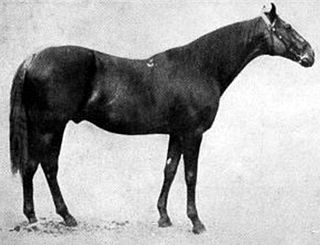
Bona Vista (1889–1909) was a British Thoroughbred racehorse. As a two-year-old he won the Woodcote Stakes at Epsom Downs. As a three-year-old he won the Newmarket Biennial Stakes, before winning the 2000 Guineas Stakes by one and a half lengths. He was trained by William Jarvis and owned by Charles Day Rose. After retiring from racing Bona Vista became a successful stallion, siring Ascot Gold Cup winner Cyllene. Through his son Cyllene and grandson Polymelus, Bona Vista's sire line is the most dominant in Thoroughbred racehorses today.

Kendal (1883–1908) was an English Thoroughbred racehorse. He was trained at Kingsclere by John Porter for the 1st Duke of Westminster. He was a leading two-year-old, but retired due to injury. He later became a successful stallion and was Champion sire in 1897.
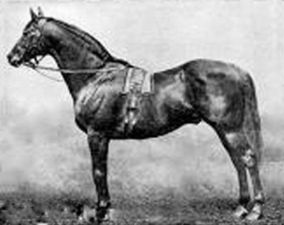
Friar's Balsam (1885–1899) was an English Thoroughbred racehorse. He was the outstanding British two-year-old of 1887, when he was unbeaten in seven races. He was a sick horse when a beaten favourite in the following year's 2000 Guineas, but returned in the autumn to beat Minting in the Champion Stakes. Friar's Balsam was retired to stud where he had some success as a sire of winners. He was trained at Kingsclere by John Porter for Lord Alington and Sir Frederick Johnstone.

Ossory (1885–1889) was a Thoroughbred racehorse. He was trained at Kingsclere by John Porter for the 1st Duke of Westminster. As a three-year-old he won the Prince of Wales's Stakes and St. James's Palace Stakes at Royal Ascot.

Frontier was a British Thoroughbred racehorse who won the Dewhurst Plate as a two-year-old and the Ascot Derby as a three-year-old. He was owned by the Hugh Grosvenor, 1st Duke of Westminster and trained by John Porter at Kingsclere.

Miss Jummy (1883–1889) was a British Thoroughbred racehorse and broodmare who won two British Classic Races in 1886. In a career that lasted from July 1885 to September 1886 the filly ran fifteen times and won eight races at distances ranging from five furlongs to one and three quarter miles. As a two-year-old in 1885, Miss Jummy won three times from seven starts, but when tried in the highest class she was unplaced behind the future Triple Crown winner Ormonde in the Dewhurst Stakes. In 1886, Miss Jummy was unbeaten when racing against her own age and sex, winning five races including the 1000 Guineas at Newmarket, the Oaks at Epsom, the Nassau Stakes at Goodwood and the Park Hill Stakes at Doncaster. She was unsuccessful in open competition, finishing unplaced in the Grand Prix de Paris and the Eclipse Stakes. At the end of 1886 she was retired to stud where her record was disappointing.

Seabreeze was a British Thoroughbred racehorse. She won several races as a two-year-old including the Ascot Biennial Stakes, but was overshadowed by Friar's Balsam. As a three-year-old she was even better. After finishing as the runner-up in the 1000 Guineas, she won the Oaks Stakes, Coronation Stakes, Lancashire Plate, St. Leger Stakes and Newmarket Oaks. Seabreeze stayed in training as a four-year-old, when she ran in top-class races, but didn't win. She was owned by Frederick Henry William Gough-Calthorpe, 5th Baron Calthorpe, and trained by James Jewitt. As a broodmare she produced some high class runners, but none matched the success of their dam.
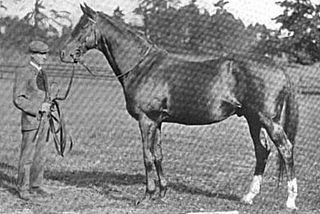
Amphion was a British Thoroughbred racehorse. He won some minor races as a two-year-old, but was not entered into any of the Classics. As a three-year-old he won several races including the Great Jubilee Stakes. He improved again as a four-year-old, winning the Hardwicke Stakes, Lancashire Plate and Champion Stakes, beating several classic winners in the process. He remained in training as a five-year-old, winning the March Stakes and Rous Memorial Stakes. Amphion was trained by Mr. Chandler and owned by General Byrne. As a stallion he sired several top class horses including the sprinter Sundridge, Champion Stakes winner Dieudonne and Eclipse Stakes winner Lally.
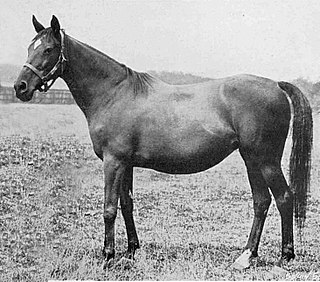
La Roche was a British Thoroughbred racehorse and broodmare. As a two-year-old in 1899 she showed some promise, winning once from six attempts, but appeared to be some way below top class. In the following season, when tried over longer distance, she emerged as one of the best horses of her generation in England, winning the Oaks Stakes, Manchester Cup, Yorkshire Oaks and Newmarket Oaks as well as finishing fourth in the 1000 Guineas and third in the Doncaster Cup. She was retired at the end of the season to become a broodmare and had considerable success as a dam of winners.

Canterbury Pilgrim (1893–1917) was a British Thoroughbred racehorse and broodmare. She showed some ability as a juvenile but failed to win a race. She won the Oaks Stakes on her first run as a three-year-old and went on to win the Liverpool Summer Cup, Park Hill Stakes and Jockey Club Cup before being retired at the end of the year. As a broodmare the best of her offspring was Swynford, a top-class racehorse who was even better as a breeding stallion. She also produced the influential sire Chaucer and several good broodmares. She has been described as "one of the most influential horses, stallion or mare, of the Twentieth Century".
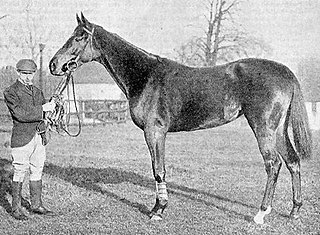
Airs and Graces was a British Thoroughbred racehorse and broodmare. As a two-year-old she raced in the colours of the 6th Duke of Portland and showed modest ability, winning one minor race. After being bought by the Australian sportsman W T Jones she showed much improved form at three in 1898, winning the Epsom Oaks and being placed in both the 1000 Guineas and the Coronation Stakes. She failed to win a race in 1900 but ran well to finish second in the Cambridgeshire Handicap. She was exported to France to become a broodmare and produced two top-class winners.
Throstle (1891–1910) was a British Thoroughbred racehorse and broodmare. Born partially blind and considered a likely candidate for euthanasia as a foal she nevertheless proved herself one of the two best fillies of her generation in Britain. She showed considerable promise despite failing to win in three starts as a juvenile in 1893 and began her second season by running sixth to Amiable in the 1000 Guineas. In the summer of her second season she made rapid progress, winning the Coronation Stakes and Nassau Stakes as well as finishing fourth against very strong male opposition in the Eclipse Stakes. Poor form in training led to her starting at odds of 50/1 for the St Leger but she created a huge upset by defeating the Epsom Derby winner Ladas. She failed to win again and was retired from racing in 1895. She had little success as a dam of winners.


















